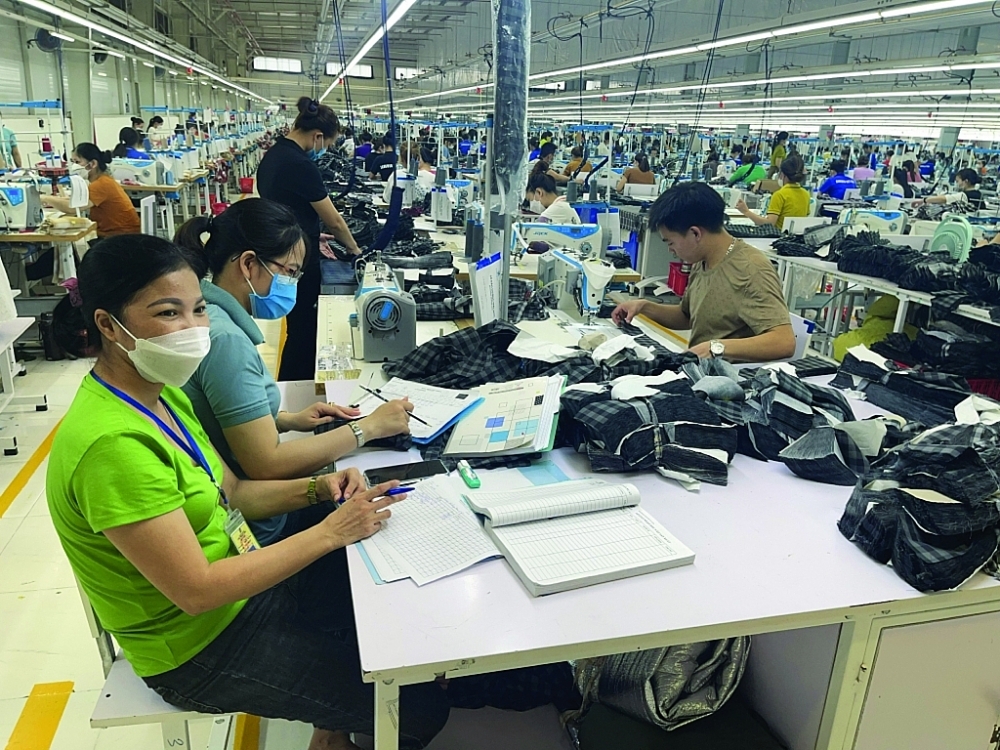| Import and export turnover no longer depends on the exchange rate | |
| Turning difficulties into opportunities, businesses accelerate exports |
 |
| Enterprises recommend that there should be stronger policies to develop a chain of links in raw materials. Photo: H.Deu |
Difficulty in self-control
According to a representative of the Vietnam Textile and Garment Group (Vinatex), many textile and garment enterprises have to spend more than 20% of the value to buy domestic raw materials due to the application of additional taxes, fees and loan costs. Therefore, accessing domestic raw materials is not easy compared to imported materials, especially from China.
Moreover, for enterprises producing raw materials and accessories, finding capital to expand production and business also faces many difficulties. According to Mr. Pham Van Viet, Vice Chairman of Ho Chi Minh City Textile, Embroidery and Knitting Association, many businesses are looking forward to a more open mechanism in credit-related issues to have large capital sources for new investment and expansion in raw material production. In addition, businesses also said that contracts for the supply of raw materials and accessories with domestic enterprises are mainly short-term, in a certain cycle, it is still difficult to form a long-term supply chain, leading to businesses not being interested in investing.
Along with that, many policies have not created favorable conditions for enterprises to develop the raw material production industry. According to Ms. Phan Thi Thanh Xuan, Vice President and General Secretary of the Vietnam Leather, Footwear and Handbag Association (Lefaso), the tanning sector is of great significance to the leather and footwear industry, which has to import billions of USD each year, but is facing strict regulations related to the environment, so it is difficult for businesses to invest and develop.
In addition, environmental conditions also make it difficult for businesses to want to develop textile and dyeing projects, so businesses need more reasonable development policies.
Currently, many “billion-dollar” production and export fields in Vietnam are heavily dependent on imported raw materials. For example, preliminary statistics of the General Department of Customs show that, in the first nine months of 2022, Vietnam spent 2.04 billion USD importing seafood, up 36.8% over the same period last year. In particular, in September 2022 alone, Vietnam’s seafood import turnover reached nearly 200 million USD, up 44.5% over the same period in 2021. Although the seafood industry still achieved a trade surplus of 6.47 billion USD in 9 months of 2022, with the cost of feed accounting for 65-70% of production costs, the rapid increase in the price of animal feed also greatly affects the profits of seafood processing and exporting enterprises.
Or in the field of industrial production, many businesses have signed orders until the end of 2022 and into the first quarter of 2023, but raw materials are always a constant worry, both about lack of goods due to supply chain disruptions, while worrying about rising costs, making it more difficult to meet orders on schedule.
With the export furniture industry, in 2021, the price of wood materials will increase by about 20% and continue to increase by 20% in 2022. Vietnam’s export of wood products is forecast not to be very bright.
Need strong enough links and policies
According to experts, in order to benefit from the new-generation Free Trade Agreement as well as minimize external shocks, it is very important to be proactive in the supply of domestic raw materials. Not only that, when foreign-invested enterprises, when deciding to invest, and want to find domestic sources of raw materials and accessories to meet the requirements of localization rate, when exporting, they will enjoy tax incentives, reducing transportation costs.
Therefore, businesses recommend a stronger policy to develop into a chain of links in raw materials. For example, in China, the Government’s policy to encourage the production and export of raw materials and accessories has helped this place become an “empire” of raw materials. In September 2022, the People’s Bank of China (PBOC) announced that it would deploy more large-scale budget packages to support the economy and investment. This program will inject capital into businesses with preferential interest rates, helping businesses have more resources to restore production.
In Vietnam, the 2% interest rate support package from the state budget has been issued and put into effect, but progress is still very slow compared to the requirements, due to both banks and businesses.
According to the State Bank, the actual implementation shows that commercial banks have difficulty in determining the beneficiaries of interest rate support in some cases of customers engaged in multi-industry production and business activities. Therefore, policies on interest rate support need to be facilitated to quench the “thirst” of capital of enterprises, creating conditions for the development of the field of raw material production and supporting industries.
Besides, enterprises also suggested that the State should create conditions for domestic enterprises to receive technical processes and production skills from abroad to improve production capacity; creating opportunities to form and develop domestic value chains, through effective investment attraction and promotion of business connections and linkages between Vietnamese enterprises and multinational enterprises, manufacturing companies, etc. domestic and foreign exports. Many industry experts also said that it is necessary to first ensure the size of the domestic market to develop the source of raw materials and supporting industries before heading to export markets.
